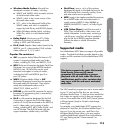
112 HP MediaSmart HDTV User Guide
Supported Media File Types
Digital media formats: Codecs
versus file containers
Despite international efforts to create standard-based
audio and video formats, many format types are
incompatible.
The codec (compressor and decompressor) is the
method used to compress and decompress digital
media files. Audio/video streams usually incorporate
two separate codecs: one for the compressed video
and one for the compressed audio. The MPEG codecs
include profiles and levels, which are the minimum
processing requirements for a compliant decoder.
Examples of codecs are:
JPEG: Used by almost all digital cameras to
compress digital images.
MPEG-1, MPEG-2, and MPEG-4: Audio and video
codecs developed by International Standards
Technical committees.
VC-1: A video codec developed by Microsoft.
Dolby Digital: An audio codec used in DVD
movies and in high-definition broadcasting.
The file container is the type of file that the digital bit
stream is stored in, regardless of the codec used. File
containers have a specific structure, which helps
decoders identify the codecs necessary for playback.
File containers may support multiple codecs, and they
may also include media metadata, DRM (digital rights
management) keys, and other stream-related
parameters. Examples of file containers are:
AVI (.avi)
QuickTime (.mov or .qt)
MP4 (.mp4)
WMV (.wmv)
DivX (.divx)
MPEG (.mpg)
Popular codecs
MPEG codecs. The Motion Pictures Experts
Group (MPEG) has developed a variety of A/V
codecs, including:
MPEG-1, which is used in VCD movies.
MPEG-2, which includes the audio codecs
MPEG-2 Layer II (MP2) and MPEG-2 Layer III
(MP3), and which is used in DVDs, in HDTV,
and in many movie download services.
MPEG-4, part 2, which is the basis for DivX,
Xvid, and other low-bit-rate codecs.
MPEG-4, part 10, also known as H.264 or
Advanced Video Codec (AVC), which is the
basis for HD-DVD and Blu-ray formats. It is
also the default video codec in iTunes.
AAC (Advanced Audio Codec), also known
as MPEG-2, part 7, or MPEG-4, part 3, is the
default audio codec in iTunes.
With MPEG-2, MPEG first introduced the concept
of profiles and levels. Profiles and levels define the
minimum processing requirements for a compliant
decoder. For example:
DVD movies use MPEG-2 at Main Profile and
Main Level (or MPEG-2 MP@ML).
HDTV uses a subset of Main Profile at High
Level (MP@HL).
Two of the most common profiles for MPEG-4,
part 2, are the Simple Profile (SP) and the
Advanced Simple Profile (ASP).
!
This device supports the codec file formats
listed herein, however HP cannot
guarantee full compatibility or proper
playback with all such codec files due to
modifications and/or other variation that
may occur with the end-user’s endcoded
codec files.


















